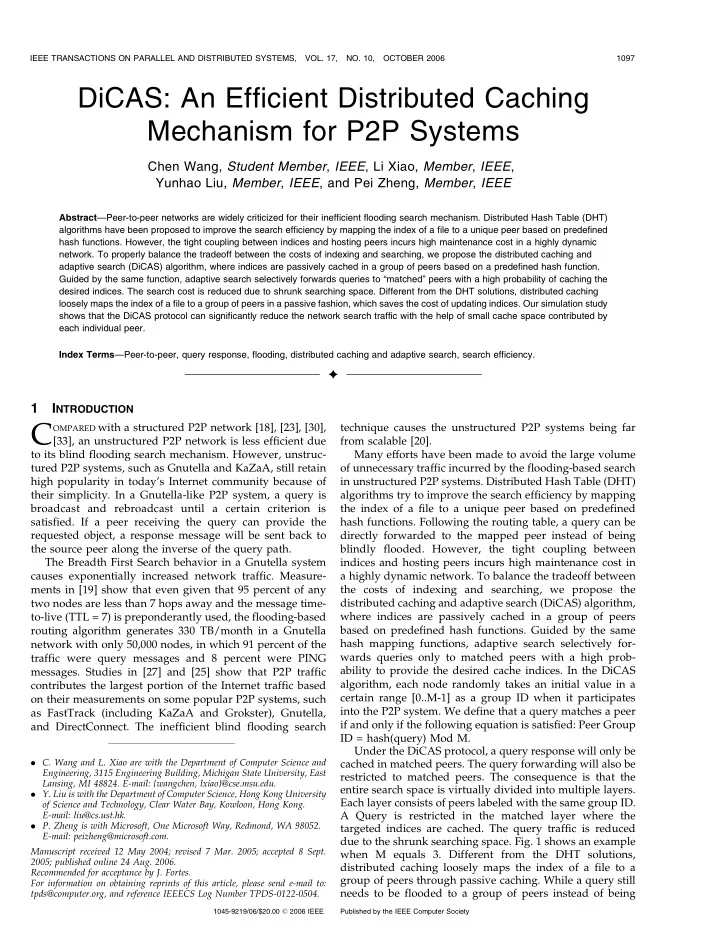

IEEE TRANSACTIONS ON PARALLEL AND DISTRIBUTED SYSTEMS, VOL. 17, NO. 10, OCTOBER 2006 1097 DiCAS: An Efficient Distributed Caching Mechanism for P2P Systems Chen Wang, Student Member , IEEE , Li Xiao, Member , IEEE , Yunhao Liu, Member , IEEE , and Pei Zheng, Member , IEEE Abstract —Peer-to-peer networks are widely criticized for their inefficient flooding search mechanism. Distributed Hash Table (DHT) algorithms have been proposed to improve the search efficiency by mapping the index of a file to a unique peer based on predefined hash functions. However, the tight coupling between indices and hosting peers incurs high maintenance cost in a highly dynamic network. To properly balance the tradeoff between the costs of indexing and searching, we propose the distributed caching and adaptive search (DiCAS) algorithm, where indices are passively cached in a group of peers based on a predefined hash function. Guided by the same function, adaptive search selectively forwards queries to “matched” peers with a high probability of caching the desired indices. The search cost is reduced due to shrunk searching space. Different from the DHT solutions, distributed caching loosely maps the index of a file to a group of peers in a passive fashion, which saves the cost of updating indices. Our simulation study shows that the DiCAS protocol can significantly reduce the network search traffic with the help of small cache space contributed by each individual peer. Index Terms —Peer-to-peer, query response, flooding, distributed caching and adaptive search, search efficiency. Ç 1 I NTRODUCTION C OMPARED with a structured P2P network [18], [23], [30], technique causes the unstructured P2P systems being far [33], an unstructured P2P network is less efficient due from scalable [20]. to its blind flooding search mechanism. However, unstruc- Many efforts have been made to avoid the large volume tured P2P systems, such as Gnutella and KaZaA, still retain of unnecessary traffic incurred by the flooding-based search high popularity in today’s Internet community because of in unstructured P2P systems. Distributed Hash Table (DHT) their simplicity. In a Gnutella-like P2P system, a query is algorithms try to improve the search efficiency by mapping broadcast and rebroadcast until a certain criterion is the index of a file to a unique peer based on predefined satisfied. If a peer receiving the query can provide the hash functions. Following the routing table, a query can be requested object, a response message will be sent back to directly forwarded to the mapped peer instead of being the source peer along the inverse of the query path. blindly flooded. However, the tight coupling between The Breadth First Search behavior in a Gnutella system indices and hosting peers incurs high maintenance cost in causes exponentially increased network traffic. Measure- a highly dynamic network. To balance the tradeoff between ments in [19] show that even given that 95 percent of any the costs of indexing and searching, we propose the distributed caching and adaptive search (DiCAS) algorithm, two nodes are less than 7 hops away and the message time- to-live (TTL = 7) is preponderantly used, the flooding-based where indices are passively cached in a group of peers based on predefined hash functions. Guided by the same routing algorithm generates 330 TB/month in a Gnutella network with only 50,000 nodes, in which 91 percent of the hash mapping functions, adaptive search selectively for- wards queries only to matched peers with a high prob- traffic were query messages and 8 percent were PING ability to provide the desired cache indices. In the DiCAS messages. Studies in [27] and [25] show that P2P traffic algorithm, each node randomly takes an initial value in a contributes the largest portion of the Internet traffic based certain range [0..M-1] as a group ID when it participates on their measurements on some popular P2P systems, such into the P2P system. We define that a query matches a peer as FastTrack (including KaZaA and Grokster), Gnutella, if and only if the following equation is satisfied: Peer Group and DirectConnect. The inefficient blind flooding search ID = hash(query) Mod M. Under the DiCAS protocol, a query response will only be . C. Wang and L. Xiao are with the Department of Computer Science and cached in matched peers. The query forwarding will also be Engineering, 3115 Engineering Building, Michigan State University, East restricted to matched peers. The consequence is that the Lansing, MI 48824. E-mail: {wangchen, lxiao}@cse.msu.edu. entire search space is virtually divided into multiple layers. . Y. Liu is with the Department of Computer Science, Hong Kong University Each layer consists of peers labeled with the same group ID. of Science and Technology, Clear Water Bay, Kowloon, Hong Kong. E-mail: liu@cs.ust.hk. A Query is restricted in the matched layer where the . P. Zheng is with Microsoft, One Microsoft Way, Redmond, WA 98052. targeted indices are cached. The query traffic is reduced E-mail: peizheng@microsoft.com. due to the shrunk searching space. Fig. 1 shows an example Manuscript received 12 May 2004; revised 7 Mar. 2005; accepted 8 Sept. when M equals 3. Different from the DHT solutions, 2005; published online 24 Aug. 2006. distributed caching loosely maps the index of a file to a Recommended for acceptance by J. Fortes. group of peers through passive caching. While a query still For information on obtaining reprints of this article, please send e-mail to: needs to be flooded to a group of peers instead of being tpds@computer.org, and reference IEEECS Log Number TPDS-0122-0504. 1045-9219/06/$20.00 � 2006 IEEE Published by the IEEE Computer Society
Recommend
More recommend